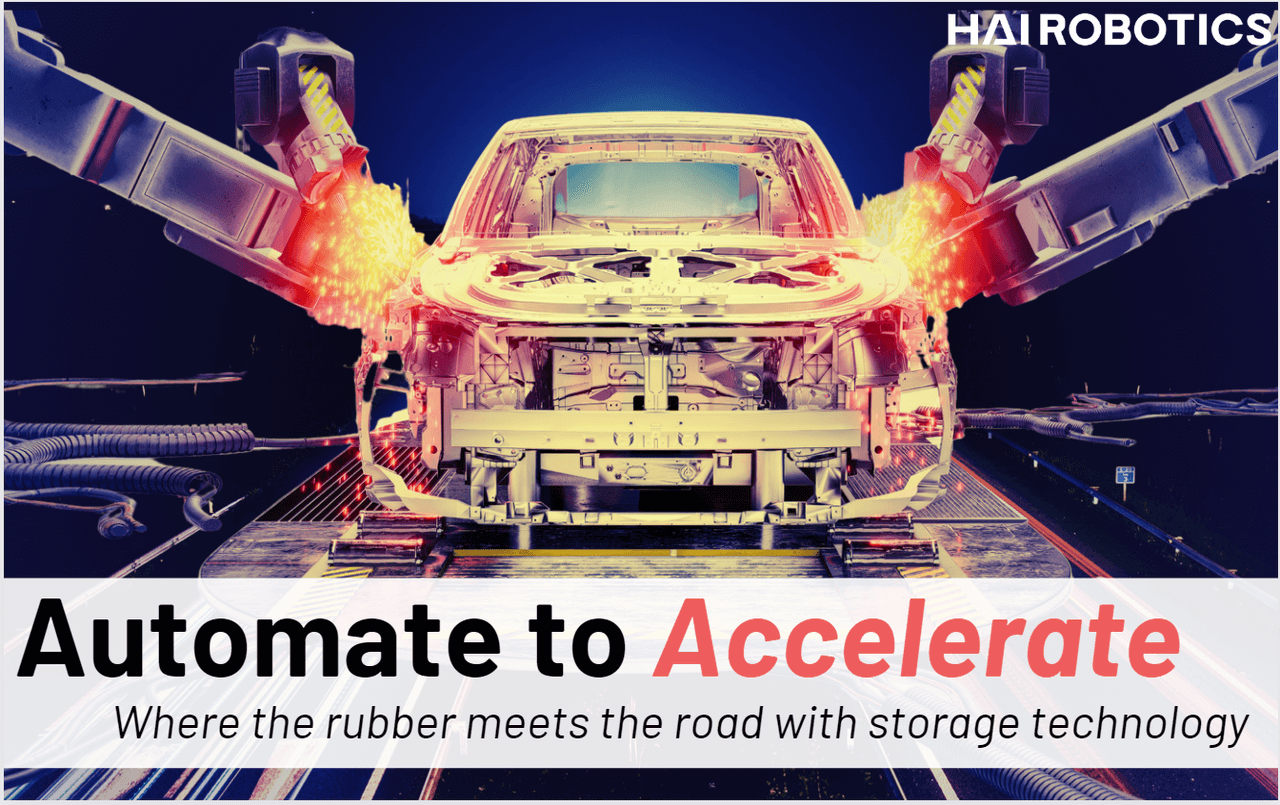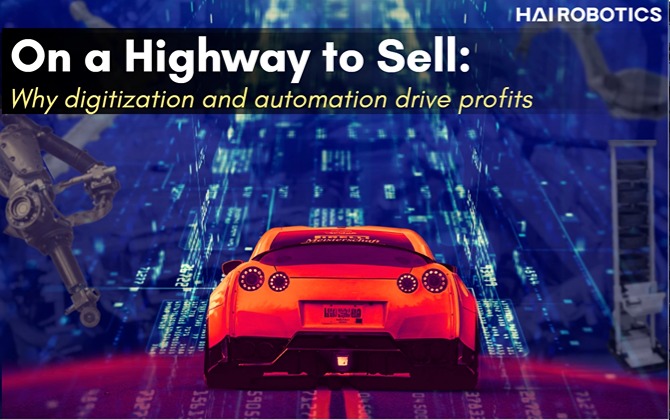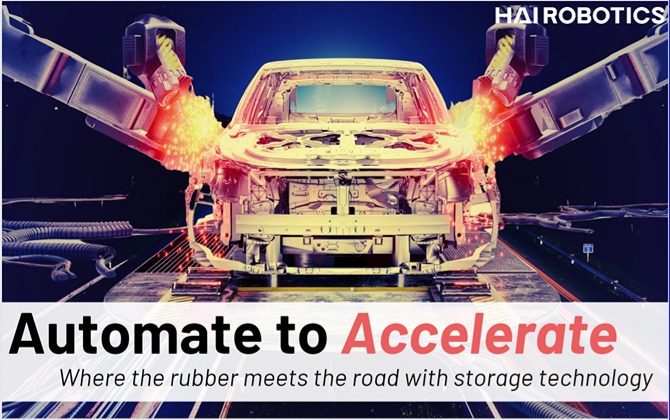How to Improve Automotive Warehousing with the Right Automation Choices
It's no secret that warehousing has come a long way since clipboards thick with paper and back-straining tire lifting. Automation has evolved how companies operate their storage facilities and manage their all-important consumer data. With the rise of e-commerce, operational efficiency, order accuracy, and rapid delivery speed have never been more vital for B2B and B2C businesses.1
This is becoming increasingly true for automotive companies, especially those who supply after-market parts and components. These companies are learning from e-commerce companies how deploying the correct technologies will help them maintain their competitive edge by improving how they store and manage their inventory and deliveries.
"The automotive industry is actively adopting digital tools and technologies to streamline manufacturing and retailing processes, reduce production costs, and extend its reach to a broader customer base."2
Automotive part producers have been looking into automation for their parts storage. Yet determining which warehouse automation to implement, how much equipment to roll out, and which can net the best ROI can be overwhelming.
"The complexities of managing warehouses in the automotive sector extend far beyond mere storage and inventory control; they encompass complex logistics, quality assurance, and timely distribution to keep production wheels turning seamlessly."3
To help automotive companies navigate the complexity of warehouse automation, we've put together a road map to help show how these emerging technologies can lead to success.

How Automation Steers Automotive Storage Toward Success
Warehouses in the automotive industry stand out from other industries because to properly manage their inventory they must use specialized infrastructure, equipment, and skilled personnel to meet production requirements.4
Not only do automotive companies must consider unique management requirements, but they must also take into consideration the facilities themselves. Facilities in the automotive industry need to facilitate automotive packaging, automotive kitting, and automotive sorting which require more attention than many common products in the e-commerce industry. These are among the special workflows and methods that differentiate automotive fulfillment from other industries.
However, just because they use different equipment and workflows than other e-commerce companies does not mean that their storage facilities don't impact the supply chain similarly.5
Like in e-commerce, automotive warehousing is a critical, and often first link in the logistics supply chain. These warehouses manage inventory, order fulfillment, and act as product distribution hubs for everything from fully manufactured vehicles to after-market parts.
In a 2023 survey conducted by ABB, nearly 40% of all automotive respondents stated that new OEM start-ups and pop-up manufacturers are embracing and investing in robotics and automation more than other domains. However, nearly 40% believe that Tier 1 suppliers are embracing and investing quite heavily in this area as well.6
A top priority is ensuring the flexibility and robustness of the storage, management, and timely distribution of components and vehicles to manufacturers, dealerships, and end customers. Companies using traditional manual person-to-goods workflows struggle with balancing efficiency and storage density with the necessary meticulous storage management and workflows.7
To optimize storage, improve inventory management, and increase the accuracy and efficiency of product distribution, businesses have turned to a wide range of technologies and systems that encompass the broad term called warehouse automation.8
Key technologies included in warehouse automation include but are not limited to:
-
Robotics and autonomous vehicles
-
Autonomous Case-handling Mobile Robots (ACR), Autonomous Mobile Robots (AMR), and Autonomous Guided Vehicles (AGV)
-
-
Automated conveyor systems
-
Dynamic Routing and Sortation Systems
-
-
Goods-to-person systems
-
Shuttle Systems and Vertical Carousels
-
-
Automated sorting and packing
-
Machine Image and Recognition Software
-
Robotic Packing9
-
We previously mentioned that unique industry aspects such as automotive packaging, automotive kitting, and automotive sorting require more bespoke and robust technologies than other industries. Adopting flexible smart automation systems ACRs and AMRs help optimize automotive warehouses and other facilities in the automotive industry. OEM part manufacturers can benefit from robotics such as ACR, AMR, and other AGV solutions to help transport parts from storage racking to workstations where operators can scan and distribute the products for delivery.
"AGVs are used to fill up containers and pick them up for inbound or outbound processing." according to an Automation.com article "Furthermore, the automotive sectors are increasing the number of production and transportation units, which suggests the utilization of AGVs and AMRs."10
ACRs and AMRs paired with automated conveyor systems and other hardware synced with Warehouse Management Software (WMS) platforms that handle inventory management, order fulfillment, and real-time tracking successfully tackle many of the aforementioned challenges.11 Hyundai has leaned into warehouse automation by officially launching its new state-of-the-art Hyundai Motor Group Innovation Center Singapore (HMGICS). This 'smart urban mobility hub' installed 200 robots that can produce 30,000 customizable EVs annually.
"The robots play a crucial role, handling 50% of all tasks, including assembly, inspection, production, and 60% of component processing, ordering and transport, allowing human workers to focus on more creative and strategic tasks."12
Pushing Digitization into Overdrive
In addition to robotics, automotive companies are also increasing their digitization for better data analytics and order tracking with advanced software and other devices.
RFID tracking through WES and Warehouse Equipment Systems (WES) and other software platforms enhances layout optimization and "[provides] real-time visibility into inventory, [improves] order accuracy, and [enables] data-driven decisions for layout adjustments."13
The digital transformation of inventory management in the automotive industry expands into careful organization and categorization of automotive parts and even whole vehicles14. These advances in inventory management allow for efficient retrieval and distribution at a moment’s notice.
According to the previously mentioned ABB survey, 96% predict digitalization will become significant over the next five years with 97% of automotive respondents believe that automation and robotics will change the face of the industry.15
Automotive warehouses typically make use of state-of-the-art inventory control and tracking systems to guarantee real-time control over inventory levels and maintain precise and effective restock operations.16
"This shift towards digital transformation aims to boost productivity, flexibility, and customization, ultimately benefiting both manufacturers and consumers - with demand ultimately reshaping the supply and production infrastructure," states Ilkhan Ozsevim of Automotive Manufacturing Solutions."17
Virtual simulation is another revolutionary software integral in the digital transformation of warehouses that helps plan and optimize the layout and design of their facilities. In 2022, BMW spearheaded its digital transformation by designing its upcoming Debrecen production plant entirely through virtual simulation by leveraging NVIDIA's Omniverse system.
"Virtualisation is allowing for ecosystems that accelerate planning processes by enabling global teams to collaborate in real-time."18
Firing on All Pistons, Optimizing the Supply Chain
" Automotive companies are increasingly turning to technology to streamline their supply chain processes."19
The complexity of global supply chains has increased, especially since the pandemic and as a result, warehouses need to turn to advanced tools to manage inventory and coordinate movements effectively. Automation is a driver to help deal with the growing intricacy of supply chains in all industries, including the automotive industry.
Since robotic technologies and intelligent software platforms together can accomplish significant labor cost reduction, space optimization, and error reduction within their facilities, they are calculating how they can reap the benefits outside of those four walls. Throughout the supply chain in e-commerce companies, automotive companies are turning their attention increasingly toward automation to achieve the same.
In ABB survey, 41% of Automotive Industry respondents said that supply chain disruptions, parts storages, and inventory management remain one of the leading issues behind automotive industry challenges.20
Robotics can help streamline the supply chain by consolidating orders and automating processes. Consolidating orders by allowing goods of various sizes, shapes, and weights together lowers costs as it reduces the number of deliveries and shipments as well as personnel touchpoints for each order.
By optimizing the supply chain automotive companies can improve efficiency, reduce costs, and remain competitive in the market. This increased efficiency and competitiveness helps ensure that they can deliver the right parts and components to their customers on time and at the right price."21
Automating these processes can help reduce costs as it eliminates repetitive and needlessly prolonged manual work labor. Additionally, predictive analytics help automotive businesses better understand their consumers so they can preemptively adjust their inventory and schedules to prepare in advance for changes in demand.22
In short automotive companies increase supply chain resiliency which in turn, boosts their competitive advantage in an accelerated global market with automation.23 Even by making returns easier and accelerating fulfillment to match a growing demand for faster delivery times, automation boosts customer satisfaction which is crucial in a tightening consumer market.
"Automation unlocks efficiency, precision and creativity, transforming the way goods move, store and deliver, leading to a more efficient and seamless supply chain ecosystem."24
Auotmation can help automotive companies not just improve their storage management and inventory within their facilities but can help streamline their supply chains by improving their fulfillment methods. At Hai Robotics, our experts are always at hand for a conversation to discuss which flexible and scalable automation systems are the correct solution for you.
Click the button below to contact our automation experts:
Footnotes
1 & 8 & 9 & 11 & 23. Arden, Ellva. “Automation in Warehousing: Transforming the Future of Logistics.” LinkedIn, 13 Sept. 2023. (article 1)
2 & 17. Ozsevim2024-01-03, Ilkhan, et al. “The State and Stipulation of Automotive Production: Retrospect 2023 to Prospect 2024.” Automotive Manufacturing Solutions, 3 Jan. 2024.
3 & 13. Raogunjanyadav. “Strategies for Effective Warehouse Management for the Automotive Industry.” Medium, 25 Sept. 2023, Accessed 8 Mar. 2024.
4 & 5 & 7 & 14 & 16. “Comprehensive Guide to Automotive Warehousing.” Mahomed Sales and Warehousing, Accessed 8 Mar. 2024.
6 & 15 & 20. Automotive Manufacturing Solutions. "AMS, and ABB Asea Brown Boveri. Automotive Manufacturing Outlook Survey 2023." Asea Brown Boveri, 2023.
10 & 18 & 24. Dive, Harshada. “Logistics Automation Industry’s Role in Revolutionizing Supply Chain Operations.” Automation.com, 21 Sept. 2023, Accessed 8 Mar. 2024.
12. “Hyundai Unveils Robot-Operated EV Plant in Singapore.” Automation.com, 27 Nov. 2023, Accessed 8 Mar. 2024.
19 & 21 & 22. “Guide to the Automotive Supply Chain.” Everything Supply Chain, 6 Jan. 2024, Accessed 8 Mar. 2024.


